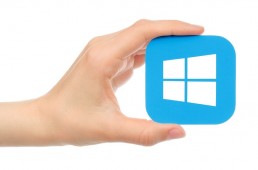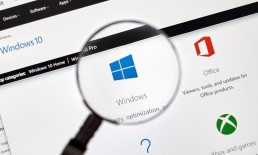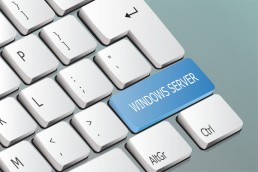Installing Windows Server - it's quick and easy!
Installing Windows Server - it's quick and easy!
Windows Server installation – the preparation
Before you can install the Windows Server, you must ensure that the most important system requirements are met. In addition, the device drivers should be updated so that the installation of, for example, Windows Server 2022 is possible without complications. These two steps serve as preparation for installing the Windows Server and should be followed regardless of the respective Windows Server versions.
System requirements
The system requirements for the new Windows Server are primarily directed at the hardware components. They include the following points:
- 64-bit processor with 1.4 GHz.
- Compatible with x64 instruction set.
- 512 MB or 2 GB, respectively, should the installation option „desktop display“ be selected.
- ECC (Error Correcting Code) type or equivalent for physical host provisioning.
- Support for NX and DEP.
- CMPXCHG16b, LAHF/SAHF and PrefetchW supported.
- Second Level Address Translation (EPT or NPT) support.
Important: Regardless of the system requirements, the necessary Windows Server CALs should be available. Only then can the new version of the Win Server be used as desired.
Update device drivers
If all system requirements are met, it makes sense to update the device drivers. By installing the latest drivers, you can ensure that they work properly with the current server.
Windows Server – Installation and Configuration
The installation of the new Windows Server works in the familiar way: It is delivered with the Windows Installer and can then be installed in two ways. Those who are familiar with the command line can use it for the installation, otherwise a GUI is available. After successful installation, the user finds himself on the desktop, which directly integrates the Microsoft Edge browser. The desired configurations can be made via the Server Manager, whereby the developers have hardly changed the interface. The Windows Admin Center, on the other hand, has been updated and looks more modern and appealing. All in all, both the installation and the configuration work as in previous years. This means that it remains easy to use for most administrators.

More security with Windows Server 2022
While there are some functional innovations in the new Windows Server version – the focus is on the significantly increased security level.
- Multi-layered Secured Core security features provide increased protection against modern cyber attack threats. These functionalities extend across the operating system, firmware and hardware: a plus point that quickly makes itself felt in the company.
- Preventive defence mechanisms help companies protect their sensitive information. In doing so, they detect advanced malware at an early stage and ward it off, which could otherwise manipulate the system.
- Advanced Threat Protection helps detect and stop data leaks, network attacks and zero-day vulnerabilities.
- Windows Defender Exploit Guard prevents intrusion attempts that target the host.
- Virtualisation-based security prevents attackers from introducing malware should they wish to exploit a vulnerability in the operating system.
- End-to-end encryption ensures that data is secure on untrusted networks
What to do after the Windows Server installation
In order for the new server to function properly, the most important points should be observed after the installation. This includes, for example, installing the latest updates provided by Microsoft’s update server. The group policies must also be set and the range of functions adjusted as desired. In addition, the following steps are important.
- Load and optimise workload templates: Those who choose to use templates should optimise them afterwards. Since they are designed to be used in a wide variety of companies, they are sure to differ from the actual requirements of the company.
- Set settings for virtualisation in the BIOS: These settings should always be checked separately. Especially if the server is to run Hyper-V, the most important adjustments must be made.
- Update drivers: Missing drivers for different devices may need to be installed. On the other hand, those that are not up to date must be updated in order to work best with the current server.
- Update firmware: In addition to the drivers, the firmware version must also be updated.
- Check product key and activation: The product key is not always activated automatically during installation. Therefore, it is important to check whether the activation was successful. If this is not the case, it must be deposited again in order to be able to use the full range of functions.
Header image: © rvlsoft, stock.adobe.com
The differences between Windows Server and Windows OS
The differences between Windows Server and Windows OS
The basis: similar code
What are the advantages of Windows Server? Windows OS and the Windows Server have numerous differences. Nevertheless, they have a common basis: the source code. This serves as a kind of agreement through which it is possible to switch back and forth between the Windows OS and the Windows Server. Since both have the same task view, desktop and start buttons, it can sometimes be difficult to tell them apart. The similar code also helps to make it possible to use the same kernel on both, i.e. the central part of the operating system, as well as the same software. However, in order to access the Windows server, so-called Windows Server CALs are needed to access the Windows server. Only if they are available in sufficient numbers can a network connection be established. For users, the advantages of the Windows server are not least that preferred applications such as Microsoft Office or Google Chrome can be used on both.
The advantages of Windows Server
The advantages of a Windows Server are obvious for many companies, which is why they regularly opt for a new version of the product. Although it is not necessary to always run the latest edition, it should be considered as soon as major changes are imminent that will take the company further. The latest version of Windows Server stands for more security and a fundamental modernisation of the infrastructure, which is why the investment pays off in most cases:
- The new platform supports a hybrid IT environment and is equally flexible, scalable and ready for the cloud.
- Companies can choose a so-called Azure Edition so that they receive a direct connection to the Microsoft Azure data centre. This means that investments already made can continue to be used.
- A better network connection, additional virtual machines and a revamped admin interface increase the efficiency of administration and make the data centre’s work easier.
- The combination of a local infrastructure and the cloud resources used is favoured by optimised server management.
- The modern server version also shows that the advantages of Windows Server focus strongly on containerised applications. This increases performance while simplifying development and deployment.
- Remote access for external employees, employees in the home office or remote workers is noticeably simplified. Since data and applications are available at any time and from any location, comfortable and productive work is possible.
- Another advantage of Windows Server is the increased and multi-layered security functions. They simplify protection against cyber attacks and protect sensitive company data as well as the apps.

Management software specifically for businesses
The Windows server is mainly used in companies, where it is used to run numerous services over a specific network. For simple offices or schools, on the other hand, a normal Windows OS is sufficient for day-to-day tasks in most cases. For this reason, the management software is specially tailored to the needs of companies and allows them comprehensive administrative control: from applications to data storage to the company network.
Fewer hardware restrictions
The new server from Microsoft makes it easier to connect additional hardware components to the existing system. In most cases, the appropriate software is offered directly for new end devices such as a printer. The same applies to other parts of the hardware, for example an extension of the existing memory.
Only relevant functions
Since Windows Server 2022 is aimed at different companies, it contains a wide range of functions. This includes all central aspects that are important in the daily workflow. Of course, not all functions have to be used: Instead, the company has a set of tools at hand with which the individual departments can be supported.
Conclusion
Companies benefit from the numerous advantages that the new Windows Server offers them. While most functions have been fundamentally improved, new approaches can also be found in the latest edition. These include, among other things, the focus on security. This makes the new Windows Server an important companion especially for companies that would like to use cloud computing. Private users, on the other hand, usually manage without the high range of functions – for them, the desktop version is usually sufficient.
Header image: © dennizn, stock.adobe.com
Windows Server 2019: Important innovations at a glance
Windows Server 2019: An overview of important new features
Better container support, optimised interaction with Azure and easier encryption. Here's a look at the best new features in the upcoming Windows Server 2019.
Windows Server 2019 comes with a wealth of new features. Collaboration with Microsoft Azure is improved, container technology is significantly expanded and Linux finds broad support. File servers with Windows Server 2019 can also be operated much more effectively and migrations can be carried out more easily. We give a preview of the ten best new features.
All the new features from Windows Server 1709/1803
Windows Server 2019 will include all the new features from the semi-annual versions Windows Server 1709 and Windows Server 1803. These include optimised container management, better Storage Spaces Direct, expanded support for Linux and more. There’s also the added benefit of Windows Server 2019 getting a graphical interface to make the new features easier to manage.
New container image with almost complete Windows server
With Windows Server 2019, Microsoft provides a new container image with the current name „windows“. In addition to the two images „nanoserver“ and „windowsservercore“, the „windows“ image is supposed to have a greatly expanded range of functions with which almost all Windows programmes can be used. This means that developers can also run apps in containers with which this is currently not possible.
Kubernetes support and better containers
In general, Microsoft wants to improve the work with containers with Windows Server 2019. Windows Server 2019 will work directly with Kubernetes so that hybrid container environments can also be operated. The individual images for containers will be improved. For example, the core image will be further reduced in size, the nano image will be expanded, and collaboration between containers will be optimised.
Better virtualisation of Linux servers
Linux servers can be virtualised better with Windows Server 2019. In addition, Linux servers can be secured with shielded VMs in Windows Server 2019. This is currently only possible with Windows servers. In general, Linux will connect better with Windows Server 2019.
Windows Subsystem for Linux
The Windows Subsystem for Linux enables the integration of a Linux distribution within a Windows installation. This allows Linux servers to be managed directly from Windows servers using Linux commands. Windows servers can thus also be administered via Linux commands. This improves cooperation between Linux and Windows enormously. Numerous distributions are to be added in Windows Server 2019.
Windows Defender Advanced Threat Protection (ATP)
Windows Server 2019 works directly with Windows Defender Advanced Threat Protection. This is an advanced attack protection that works without signature files and can detect zero-day attacks and root kits. The service has cloud connectivity and reliably detects attacks that are not detected by virus scanners. ATP does not replace anti-malware scanners, but complements them.
Better encryption
In Windows Server 2019, data can be encrypted easier and better. Network traffic can also be encrypted better in Windows Server 2019. This also applies to virtual machines.
Storage migration wizard from numerous sources
The new Storage Migration Service helps migrate file servers and the data to Windows Server 2019. The wizard can also move data from NAS systems, works with Microsoft Azure, and can transfer data and permissions quickly and easily. The target can be servers running Windows Server 2019, and the source can be a whole range of devices. Migrating to Windows Server 2019 should be easier than ever for this reason.
Better integration with Microsoft Azure
Windows Server 2019 works more closely with Microsoft Azure. Data can be synchronised between Azure and Windows Server 2019, data can be backed up with Azure Backup, and file servers can be populated with data from the cloud via Azure Files. Clusters can be connected to Microsoft Azure, and the aforementioned Storage Migration Wizard can also import data from the cloud or back up data to the cloud.
New express updates
Windows 10 computers and current Windows servers, as well as Windows Server 2019, will benefit from the new Express Updates. Express Updates are much smaller than the current Cumulative Updates and Delta Updates, which only reload missing updates. Express updates work much like backups that build on each other and can be downloaded and installed much faster. It also significantly reduces the number of reboots.
Header image: © AliFuat, stock.adobe.com



